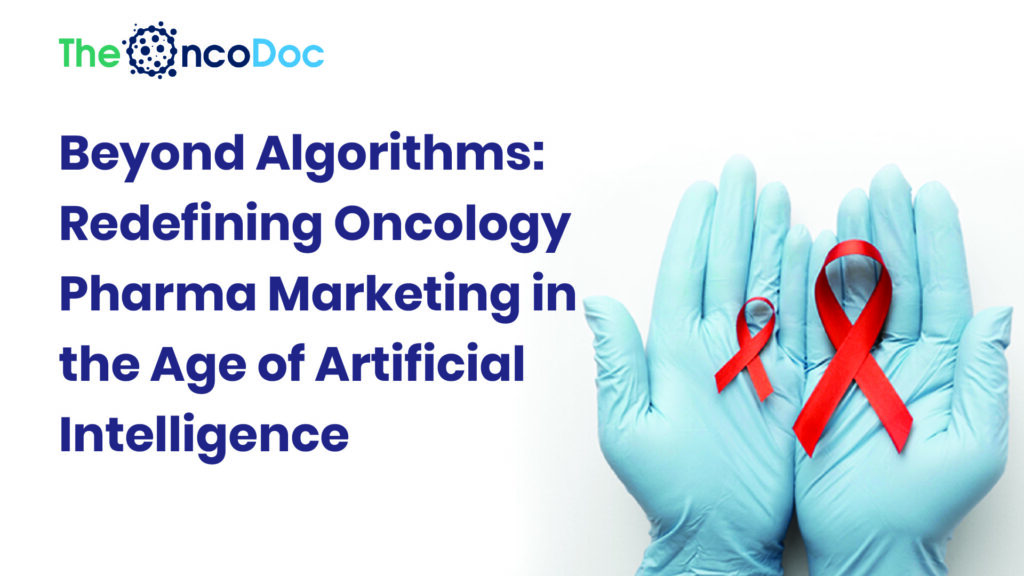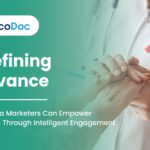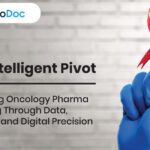Introduction: A New Frontier for Pharma Marketers in Oncology
In today’s hyper-specialized oncology landscape, clinical decisions are increasingly nuanced, shaped by molecular diagnostics, evolving guidelines, and multi-disciplinary input. At the same time, the communication between pharma and oncologists is experiencing a profound transformation. Gone are the days when success was measured by share of voice alone. Oncology brand managers must now operate in a world that demands personalization, precision, and clinical depth.
Artificial Intelligence (AI) has evolved from a futuristic idea to a useful toolkit that is changing the fundamentals of pharmaceutical marketing strategy. When used thoughtfully, AI helps pharma brands not just reach oncologists but meaningfully support them: in diagnosing faster, treating smarter, and caring deeper.
This article explores how pharma marketers can deploy AI to shift their role from information providers to clinical partners in oncology, and why this shift is crucial for both patient outcomes and brand equity.
Section 1: From Brand Visibility to Clinical Partnership
The Old Model Is Obsolete
Historically, pharma marketing in oncology revolved around broad-based outreach, webinars, CME sessions, email blasts, and product showcases. These tools still have value, but when oncologists are overwhelmed with choices and content, relevance matters more than presence.
AI allows pharma brands to refine their engagement strategy, moving from generalized messaging to micro-targeted, data-backed interventions that are grounded in the clinical reality of each oncologist.
Relevance Through Precision
An AI-powered CRM, for instance, can detect a pattern: an oncologist who frequently engages with content on EGFR mutations but not PD-L1 inhibitors. This insight allows pharma marketers to tailor follow-ups that focus on lung cancer molecular pathways, instead of flooding them with irrelevant immunotherapy data.
“In oncology, it’s not enough to talk. You have to know what to say, when to say it, and how it fits into the clinician’s world.”
— Dr. Sonal Mishra, Medical Oncologist, Mumbai
Section 2: Understanding the Modern Oncologist
AI offers brand teams a unique lens to decode behavioral, clinical, and communication patterns of oncologists, allowing segmentation based not just on geography or specialty, but on clinical behavior, engagement depth, and decision contexts.
AI-Based Segmentation Framework
- Behavioral Segments: High-content consumers vs. referral-oriented oncologists
- Practice Type: Tertiary hospital-based vs. stand-alone practitioners
- Content Preferences: Algorithm-based learners vs. case-discussion enthusiasts
Oncologist Digital Behavior by Segment
This AI-inferred segmentation can drive channel selection and content format decisions.
Section 3: Predictive Content Delivery; Tailoring Timing and Messaging with AI
Imagine a pharma marketing strategy that not only identifies the right oncologist but also engages them at the precise moment and through the optimal channel. This is the promise of AI-driven predictive content delivery. By analyzing a rich blend of behavioral data, ranging from past digital interactions to current prescribing habits, specialty interests, and even clinic schedules, AI empowers brand teams to deliver smarter, more timely engagement.
AI Tools Powering Predictive Content Strategy
• Engagement Heatmaps: Analyze when specific oncologist segments are most active to fine-tune delivery timing.
• Dynamic Email Personalization: AI automatically adjusts subject lines, visuals, and body content in real time, tailoring communication to each recipient’s profile.
• Programmatic Retargeting: Ensures brand visibility only on clinically relevant platforms frequented by target oncologists, avoiding message fatigue.
Case in Point:
A leading pharma brand launched an AI-driven immuno-oncology campaign targeting oncologists treating Stage IV melanoma. By aligning email content drops with the release of ASCO guideline updates, the brand achieved a 2.4x boost in email open rates. Additionally, field force interactions with digitally engaged HCPs rose by 40% within just two weeks of campaign launch.
This illustrates how predictive orchestration is no longer a futuristic concept, it is a current necessity for maximizing clinical engagement and shortening conversion cycles in oncology marketing.
Section 4: AI for Risk Stratification and Geo-targeting
AI helps marketers understand where interventions are needed most, not just at the clinician level but at a population level. By integrating hospital registry data, regional cancer incidence, and social determinants, AI pinpoints geographies of high risk but low diagnosis.
AI Tools for Geographic Targeting:
- Heatmaps of Late-stage Diagnosis Rates
- Real-Time Prescription Volume Mapping
- Cancer Awareness Index Scores by Region
This enables brand teams to shift campaign intensity or resource allocation, say, pushing screening support in rural Assam vs. targeted therapy messaging in Delhi-NCR.
Regional Cancer Incidence vs Pharma Campaign Intensity
AI enables smarter budget allocation that maps clinical needs, not just market size.
Section 5: AI Chatbots for Symptom Triage and Patient Education
AI-powered chatbots are redefining patient onboarding and screening workflows. Pharma brands can embed these tools within HCP-facing platforms to:
- Help oncologists screen symptoms remotely
- Share educational content tailored to language and literacy levels
- Route patients to appropriate diagnostic centers
Example Use Case:
An AI chatbot deployed across Gujarat in local language assisted oncologists in triaging over 9,000 suspected breast cancer cases, leading to 14% earlier-stage diagnosis year-on-year.
Features that Matter:
- Natural Language Processing (NLP) in 8+ Indian languages
- Symptom-based logic trees mapped to NCCN/ESMO
- Seamless integration with diagnostic partners
Section 6: AI-Enhanced KOL Identification and Engagement
Engaging key opinion leaders (KOLs) is still central to oncology marketing, but traditional selection based on publications or institutional affiliation misses emerging digital influencers.
AI uses network analysis and sentiment mapping to uncover:
- Rising micro-influencers on medical forums
- KOLs with high peer resonance despite low academic output
- Regional experts with hyper-local influence
This helps brand teams build more inclusive and geographically distributed KOL ecosystems.
KOL Influence vs Engagement Metrics
Section 7: Clinical Decision Support Tools (CDSTs); Enabling Evidence-Based Precision at the Point of Care
Among the most impactful ways pharma brands can contribute to oncology practice is through the development of Clinical Decision Support Tools (CDSTs). These tools, especially when powered by AI, can process complex clinical variables such as biomarker profiles, patient comorbidities, and prior treatment lines to generate actionable, evidence-based recommendations.
By integrating real-time data interpretation and guideline-based protocols, AI-driven CDSTs support oncologists in making faster, more informed decisions, especially in complex or high-risk cases.
Key Applications for Pharma Co-Creation:
• Interactive Treatment Algorithms: Customized decision trees for therapy sequencing based on cancer stage and molecular characteristics.
• Toxicity Risk Calculators: Designed for elderly or co-morbid patients to help clinicians anticipate adverse effects and adjust regimens accordingly.
• Virtual Tumor Boards: AI-assisted platforms that simulate multi-disciplinary discussions and rank treatment options based on patient-specific data inputs.
These tools not only demonstrate scientific depth but also deliver immediate, clinic-ready utility, enhancing the credibility and value perception of pharma brands.
Important Compliance Consideration:
All CDSTs must remain strictly non-promotional and align with regulatory standards. It is essential that such tools are ICMR-compliant, include proper citations for clinical guidelines, and clearly disclose data sources and limitations.
By investing in high-utility CDSTs, pharma marketing can move beyond messaging to become an integral partner in clinical decision-making.
Section 8: Real-World Evidence (RWE) Dashboards Enhanced by AI, Making Everyday Oncology Decisions Smarter
While randomized controlled trials (RCTs) are critical for regulatory approvals, they often fall short in reflecting the nuances of everyday clinical practice. Oncologists regularly encounter patients with co-morbidities, diverse genetic backgrounds, and unique socio-economic contexts that RCTs may not fully represent. This is where AI-powered Real-World Evidence (RWE) dashboards provide immense value.
By aggregating and analyzing anonymized electronic health records (EHRs), prescription trends, patient outcomes, and even lab data, AI enables the creation of intuitive, visual dashboards that help oncologists understand how treatments perform outside controlled environments. These insights are especially critical in tailoring therapy choices for diverse patient profiles across India’s healthcare settings.
Features of AI-Driven RWE Dashboards:
• Tumor-Specific Survival Analytics: Regional survival trends segmented by cancer type to reveal geographic treatment disparities.
• Comorbidity-Adjusted Outcomes: Insights into how patients with diabetes, hypertension, or renal impairment respond to specific therapies.
• Dynamic Filters: Customizable filters for age, gender, stage, line of therapy, and location, enabling personalized clinical comparisons.
These dashboards are versatile and can be integrated across touchpoints, used by oncologists during patient consultations, presented by Medical Science Liaisons (MSLs) during field visits, or made accessible via branded HCP portals and apps.
By bridging the gap between trial data and clinical reality, pharma brands that offer AI-powered RWE tools move closer to becoming trusted partners in patient care rather than just product promoters.
Section 9: AI for Hyper-Personalized Field Engagement Strategy
In today’s oncology landscape, sales representatives and Medical Science Liaisons (MSLs) must navigate a highly fragmented clinician base with varying levels of interest, specialty focus, and digital behavior. Relying on traditional segmentation or broad outreach tactics often results in missed opportunities and diluted impact. AI changes this equation by enabling a precision-driven field strategy that focuses efforts where they’re most likely to yield clinical and commercial outcomes.
By analyzing vast datasets, including previous engagement patterns, prescription behaviors, and digital interaction history, AI helps pharma teams intelligently prioritize their outreach. This means focusing on oncologists who are not just high-volume prescribers, but those most likely to respond to a specific message, molecule, or therapeutic update.
AI Field Targeting Priorities Include:
• Responsive HCPs: Oncologists with a demonstrated interest in a specific therapeutic class or recent formulary updates.
• Unconverted Digital Engagers: Clinicians who have shown online interest (e.g., webinar attendance, toolkit downloads) but haven’t transitioned into prescribing behavior.
• Guideline-Triggered Targets: HCPs in regions or institutions recently affected by updated treatment protocols.
Such data-driven targeting ensures field efforts are laser-focused, reducing redundancy and enhancing engagement quality.
Pro Tip:
Seamlessly integrate AI tools with platforms like Veeva CRM or Salesforce Health Cloud to enable real-time feedback loops, allowing reps and MSLs to adapt strategy based on evolving behavior and needs.
With AI, field strategy shifts from broad coverage to smart impact.
Section 10: Measuring What Matters in the Age of AI
Traditional KPIs, CTR, impressions, cost per lead, are insufficient in oncology. AI enables multi-dimensional measurement frameworks:
- Clinical Utility Score: Number of times a decision tool was reused
- Sentiment Shifts: NLP analysis of survey or chatbot comments
- Conversion Lag: Time from first digital touch to Rx adoption
- Peer Amplification: How often content was shared among oncologist groups
These metrics signal long-term value creation, not just momentary attention.
Conclusion: AI as a Catalyst for Smarter, Value-Driven Oncology Marketing
Artificial Intelligence is not a replacement for pharma marketers, it’s a powerful enabler that amplifies their impact. In the oncology domain, where decisions carry life-altering consequences, AI serves as the crucial link between scientific rigor, real-world complexity, and human-centered communication.
Rather than automating for the sake of efficiency, AI empowers marketing teams to be more thoughtful, precise, and responsive in how they engage oncologists. It transforms campaign planning from guesswork into insight-driven orchestration and redefines success from volume to value.
What the Future-Ready Oncology Brand Looks Like:
✅ Delivers clinical solutions, not just promotional messaging
✅ Anticipates HCP needs using predictive analytics, instead of reacting post-facto
✅ Focuses on long-term utility, rather than chasing superficial metrics
✅ Honors clinical time and context, not just market share targets
In a landscape as demanding and dynamic as oncology, the next generation of pharma brands will not compete by being louder, they will lead by being more relevant, more intelligent, and more clinician-centric.
As AI becomes a foundational part of oncology pharma marketing, the brands that thrive will be those that adopt its capabilities not as a shortcut, but as a strategic partner in delivering better care, building trust, and driving real-world impact.
The Oncodoc team is a group of passionate healthcare and marketing professionals dedicated to delivering accurate, engaging, and impactful content. With expertise across medical research, digital strategy, and clinical communication, the team focuses on empowering healthcare professionals and patients alike. Through evidence-based insights and innovative storytelling, Hidoc aims to bridge the gap between medicine and digital engagement, promoting wellness and informed decision-making.



